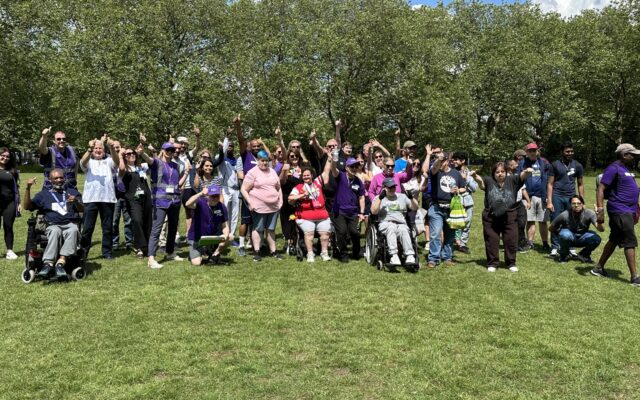The funding of self-advocacy has been a preoccupation for the movement for as long as I can remember. Ask anyone involved, and they will talk about the loss of local and national government funding, the closure of groups and the limits on what they can do.
Given this, the Open University-Learning Disability England (OU-LDE) partnership decided to look into the funding of self-advocacy in England.
The research was supported by an advisory group convened by LDE, comprising LDE, leaders of well-established self-advocacy groups, a knowledgeable local authority commissioner and the chief executive of All Wales People First. Funding came from the OU’s knowledge transfer initiative.
Checking Charity Commission and Companies House data, to our surprise we found several groups had an income in the £300,000-£500,000 range. This went against received wisdom.
Clearly, some groups are managing, despite austerity and the withdrawal of central government funding since 2017. So there is an interesting story somewhere.
Where the money comes from
Next, we undertook some interviews, focusing on why self-advocacy is commissioned in some areas but not others, how groups are funded when they lack local authority support and how self-advocacy groups perceive the pros and cons of different types of funding.
We talked to members and staff from self-advocacy groups of varying sizes and funding models, people whose jobs include commissioning self-advocacy and our advisory group.
The findings reveal a mixed picture. Certainly, local authority funding, once the mainstay, is declining and unreliable.
One group said: “It’s always been enough to keep us alive, not enough to allow us to thrive.”
However, it is not an entirely gloomy picture. There are many different ways to fund self-advocacy.
One group is funded as a day service, which members pay to attend out of their direct payments – secure, but hard to expand. Several had local authority project funding but, to get this, needed to know the right language, referring to their work as engagement and consultation.
Some actively avoided local authority funding, saying it would prevent them from criticising the council when they needed to. Others acknowledged a need to tread carefully when confronting.
Most groups sell services such as easy-read translations, accessible guides, inspections and reviews, lockdown support, training and consultancy. There are markets for all of these.
Lottery and charitable foundation funding is a mainstay, with the Lottery praised for its accessible application process. Other funders make it far less easy to co-produce applications and reports. These sources are, however, short term, and funders are resistant to funding core office costs.
In some cases, self-advocacy is funded under the radar, with people giving time for free, piggybacking on their day jobs, for example as advocates.
There are important messages here. Self-advocacy groups need to be flexible and creative to survive. Their leaders need to know how to frame funding applications or have the money to pay a professional fundraiser. The good news is that this can be done. Some groups are doing very well.
What commissioners need to know
The term self-advocacy itself is an issue. It is understood within the learning disability tent as referring to people speaking up for themselves, individually or collectively.
Elsewhere, however, it is far from clear; many local authority commissioners have limited knowledge of the sector, what self-advocacy means, why it matters and its potential value to them.
There are no kite marks, no national website where a commissioner can find their local group and no agreed definition. There is an urgent need to close these gaps.
Self-advocacy also becomes confused with advocacy. Local authorities have to fund advocacy under the Care Act 2014.
It takes a sophisticated commissioner to both understand the difference and have the skills to persuade their politicians, who may not know much about learning disability, to fund both.
One commissioner noted that their authority’s high level of spending on advocacy all went on work that was required specifically under the Care Act.
All the commissioners we interviewed recognised the value that self-advocacy brought them. All but one paid for it – he could not find a suitable group locally.
Self-advocacy helped by getting services right first time and making it possible to consult and engage meaningfully. It even saved lives by drawing attention to the need for Covid-19 vaccine prioritisation.
There is good news here. Some groups are good at getting funding, skilful at wording bids to fit local authorities’ current priorities and brilliant at selling their services. And some commissioners really get why they should be funding self-advocacy, even if they struggle to do so.
But things could be a lot better. There are areas with no active groups. An information campaign on self-advocacy, why it matters and how it helps local authorities meet their obligations to consult and engage is urgent.
Leaders of self-advocacy organisations need opportunities to learn about selling themselves and about fundraising. And funders could think hard about application processes that can be co-produced, and imaginative ways to monitor provision.
Self-advocates, when asked what they would do if funding was unlimited suggested a kitchen where people could learn to cook healthy food, a drop-in for care homes so more people could learn about self-advocacy, formal certification for self-advocates’ job skills and help to learn to use technology.
What a wonderful world that would be.
A link to the research report will be published at www.open.ac.uk/health-and-social-care/research/shld/news





